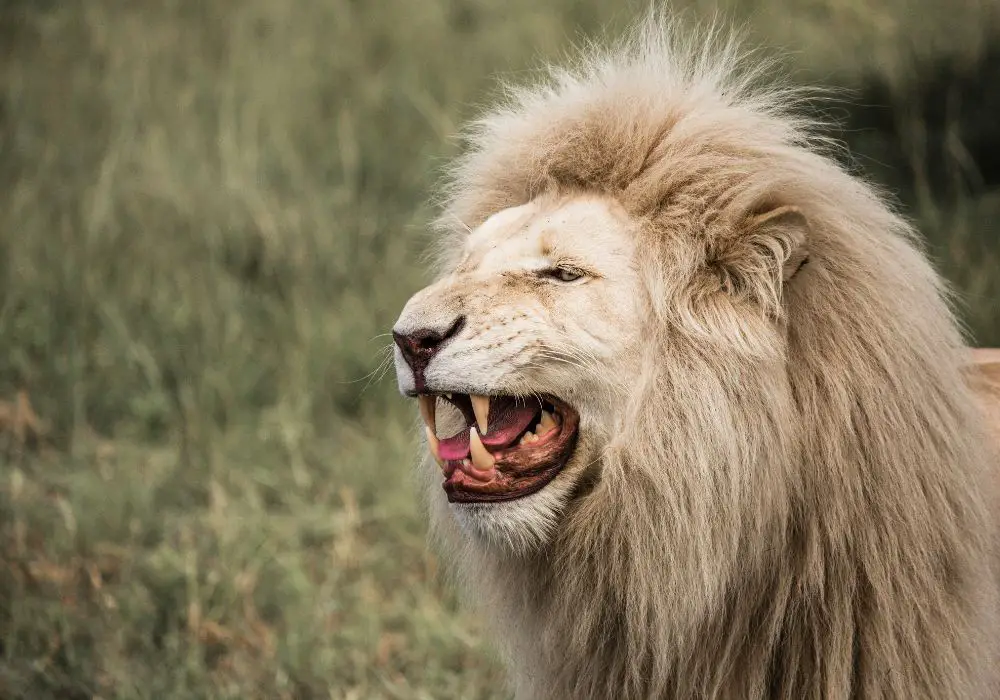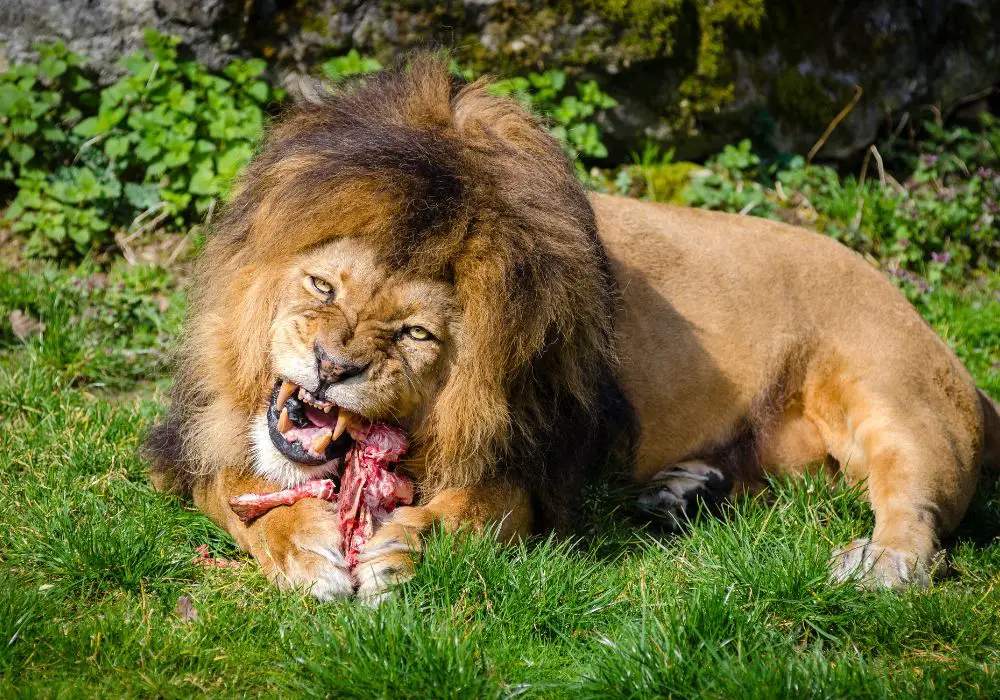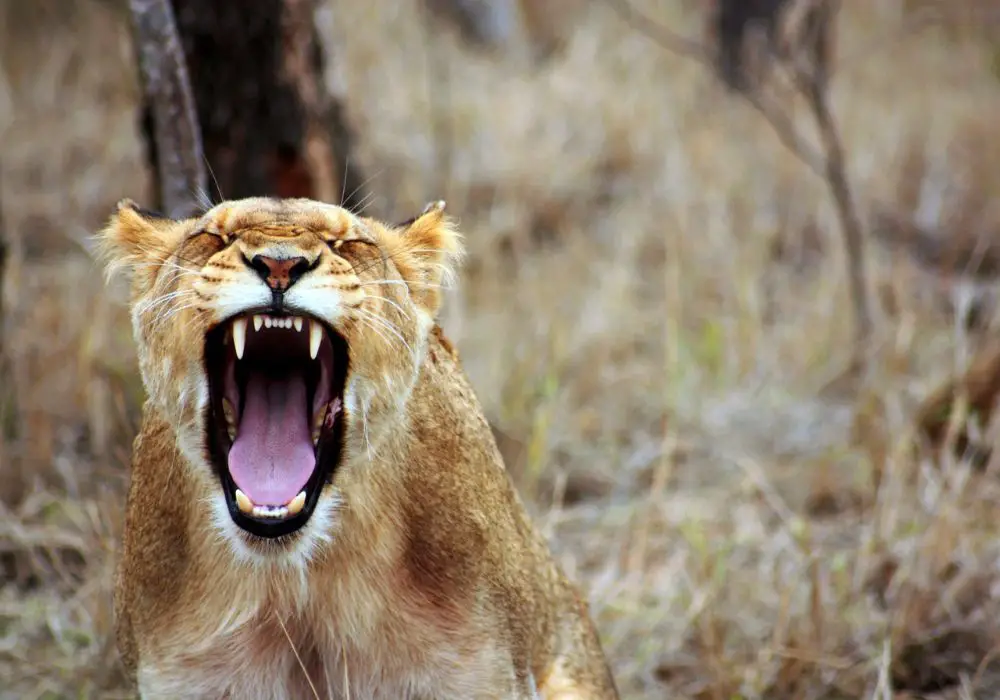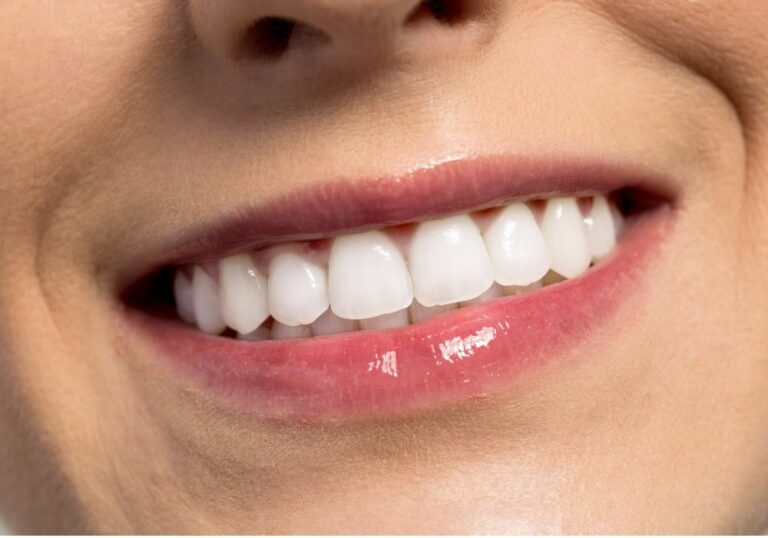Lions are majestic creatures with a powerful reputation. Just the mention of them may evoke images of the African savannah, thick, majestic manes, and long, powerful teeth framing a shaking roar.
Lions have 30 teeth that are the culmination of years of evolution, and the backbone of a lion’s hunting and social habits. While the king of jungle reputation is based on more than just “big teeth”, they certainly help.
Understanding lion teeth goes beyond viewing them as powerful predators. In this guide we explore how their teeth develop, what different types of teeth are used for, and how a lion’s bite differs from other animals.
Let’s get started!
How Many Teeth Do Lions Have?
Milk Teeth vs. Adult Teeth in Lions
Lions (scientifically known as panthera leo) have 30 teeth, but they don’t pop out of the womb with a full set of teeth. Like most other mammals, they start off with what are known as milk teeth or deciduous teeth.
When they’re just cubs, these teeth are limited to incisors, canines, and premolars. The baby teeth fit the smaller, developing jaws of the younger mammals, but still allow them to start chewing bits of meat around 3 months old.
By the time the young lions reach 15 months of age, they’ve likely developed all 30 of their permanent teeth. These are important tools that should last the remainder of the lion’s lifetime, allowing them to act as apex, keystone predators until they take their last breath.
Types of Adult Teeth Lions Have (and Their Importance)

Adult lion teeth include:
- 12 incisors
- 4 canines
- 10 premolars
- 4 molars
Even the incisors (the smallest of the bunch) are much larger than the largest of baby teeth, and they’re strong enough to solidify a lion’s hunting habits.
Like your own teeth, each type serves a different purpose, but all keep these creatures at the top of the animal kingdom.
Incisor Teeth
A lion’s incisors are the smallest teeth in their mouth, but they’re no less important. The 12 teeth are divided among the upper and lower jaw at the front of the mouth. On the top, the ones closest to the canines are bigger, and there’s a gap for the lower canines so the mouth may fully close.
The small, sharp teeth are useful for pulling meat from the bones and skin. They lock onto the food, allowing the king of the jungle to tear it carefully and cleanly.
Because of this precision, lions can empty the stomach of their prey in a way that doesn’t contaminate the surrounding organs and tasty meat. They may not be able to crush bones like other big cats, but they use as much of their kill as they can.
Canine Teeth
Lions and other big cats are famous for their large canine teeth. The ones in a lion’s mouth reach 7 cm long (2.5 inches), and they’re a fearsome sight.
The canine teeth of a lion are long, conical, and curve slightly back toward their skull. Unlike other felines (like your average housecat), a lion’s canines are actually blunt.
Contrary to popular belief, these aren’t used for tearing their catch apart. Combined with a powerful bite, the lion’s canines are used to crush or puncture the windpipe of their prey, holding them in place until they quickly suffocate and die.
While lions prefer to go for the throat of a zebra or wildebeest, they can also use these canines to completely cover the muzzle of smaller prey and suffocate the animal. Either way, canines are essential for a quick kill.
Premolar and Molar Teeth (Carnassial Teeth)
The carnassial teeth involve the premolar and molar teeth, although they differ from the flat appearance of herbivores and omnivores like humans. Instead, a lion’s carnassials have high, pointed crowns that come together like the serrated edge of kitchen shears.
These teeth function like a pair of scissors, allowing a lion to cut through skin, flesh, and sinew like it’s a slow-cooked roast. You may see them eating with the sides of their mouth, using these teeth to cut their meal into bite-size chunks.
How Lions Use Their Teeth

Having such impressive teeth is half the battle. Lion’s earned their reputation by putting them to work in the most efficient ways possible.
Lions focus on larger prey, allowing them to hunt every 3 to 4 days while maintaining a diet around 5 to 7 kilograms of meat per day. While they can hunt along, you often see them hunting a group.
Lions aren’t as fast as their prey, so they must be smart when stalking and taking down their target. The males will drive the prey towards the lionesses, who will wait until they’re close before charging and going for the take down.
It’s rarely a seamless process, and the lions want to limit the time between knocking their prey off balance and crushing their windpipe as much as possible. They usually go for the back of the neck or the throat once they’re on the ground, and then hold on as suffocation takes over.
It’s not uncommon for a lion’s canines to break during this process as their prey struggles, rolling or even kicking at their face. Some larger animals, like buffalos, can last hours before they finally let in.
The strongest male lions will eat first. They usually start at the stomach area, which proves to be the easiest way to access the meat (as well as the most nutritious parts), but they must take care not to rupture the stomach.
Lions do not chew as we would; they use their teeth to slice up the meat into sections small enough to swallow whole. Their teeth and jaw strength are also poorly suited to crushing bone and cartilage, but they use their pupillae-covered teeth to strip these hard parts of as much meat as possible.
If there’s anything left, the lions will rest close to it so they can keep away scavengers and get as much out of it as possible. Most carcasses are used up in about 24 hours.
How Strong is a Lion’s Bite?
A lion’s bite can reach 650 PSI (pounds per square inch). This is a relatively weak bite when compared to:
- Grizzly bears: 975 PSI
- Tigers: 1,050 PSI
- Spotted hyenas: 1,100 PSI
- Jaguars: 1,500 PSI
They make up for this with their unique jaws and teeth. While lions have fewer, short teeth, their jaws open quite wide. They know how to use those blunted canines to their advantage (crushing windpipes instead of ripping up their prey) and focus on hunting in groups to reach a success rate around 30 percent.
Do Lions Need Special Care for Their Teeth?

Teeth are obviously very important for a lion, and a compromised mouth can be disastrous. In the wild, lions eat a more natural, abrasive diet that naturally keeps their mouth fairly healthy.
They’re still prone to the same issues that we are, including:
- Damaged or lost teeth
- Tooth decay
- Gum disease
While lions live much longer in captivity than they do in the wild, their softer diet actually contributes more to dental health issues than they would have while running free. Because of this, zoos must have a plan to provide optimal dental care and intercede when necessary.
They try to provide foods that can help scrape plaque-causing bacteria from the lion’s teeth, but this only does so much. It’s not exactly easy to do a close, in-depth dental exam either.
Captive lions are sedated and brought in for dental and overall health exams on a regular basis. During these sessions, the teeth are cleaned and any necessary repairs are performed to make sure the lion stays as healthy and comfortable as possible.
This isn’t true for lions running around in large-scale sanctuaries, and it’s unwise to interfere this way for wild lions.
A Note on Poaching and Lion Teeth
While we’re talking about captive lions, we want to touch on poaching and how it relates to lion teeth. It’s highly unlikely that you will ever find an ethically-sourced lion tooth, so make sure you steer clear of any that you see for sale.
Lions are regularly hunted in retention for their targeting of livestock, but they’re also a major prize for trophy hunters. Lions were once endemic across Europe, the caucasus, Africa, and India, but widespread hunting has limited most populations to sanctuaries in the latter two areas.
Despite these havens, poachers regularly target them for the thrill as well as the demand for certain body parts. Teeth and claws are at the top of this list, and they’re often sold as souvenirs or even crushed down for medicinal purposes.
Conclusion
Lions are generally well-respected creatures with a spirit that invokes awe in many. Their teeth are only a small part of their overall, immense power, but they’re an important part of setting a solid foundation for these predators.
Most lions don’t have access to regular dental care (not that they would want it anyway), but their lifestyle allows them to soar through life with most of their 30 natural teeth unscathed.
While their populations have dwindled dramatically due to hunting, it’s hoped that human intervention can help keep these guys strong, healthy, and on top in the years to come.







